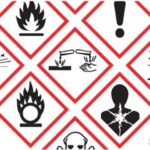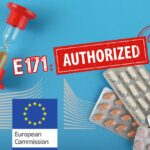
Information on nanos in SDS

What information on nanos do you get in the Safety Data Sheets (SDS)?
By the AVICENN team – Last modification September 2022
SDS: a necessary information medium for better protection of workers
The purpose of safety data sheets (SDS) is to enable workers to handle substances and mixtures safely by being informed of possible risks and any necessary precautionary measures.
These documents are intended to provide comprehensive information on the properties and hazards of substances and mixtures throughout the product processing chain1These sheets were introduced by Directive 91/55, replaced by Annex II of REACH and the adapted classification criteria and labeling rules of the United Nations Globally Harmonized System (GHS) for the classification and labeling of chemicals. See La fiche de données de sécurité, Aide-mémoire technique, INRS, 2019.
No – or very little – specific data for nanos in SDS
Unfortunately, SDS very rarely contain specific information on the nanometric nature of materials or on the risks associated with their use and the recommended precautionary measures. At best, they provide data on parent materials (at the micro or macroscopic scale) with very different properties and risks.
For example, in the US, fact sheets for commercially available carbon nanotubes provide allowable exposure limits for graphite (also a carbon compound)2Cf. Nanomaterials Safety, G. Miller, F. Plummer, and E. Asmatulu, Department of Environmental Health and Safety, Wichita State University, April 25, 2014.
In Australia, according to a study by the Australian Health and Safety Agency published in 2010, only 18% of SDS provided an adequate and sufficient description to assess occupational risk, and most did not provide specific descriptions and data for nanomaterials3Cf. Safe Work Australia, An evaluation of MSDS and labels associated with the use of engineered nanomaterials, June 2010.
Korean researchers also analyzed SDSs for 97 of the nanomaterials tested by the Organization for Economic Cooperation and Development (OECD) and found4Cf. Lee, JH et al, Evaluation of information in nanomaterial safety data sheets and development of international standard for guidance on preparation of nanomaterial safety data sheets, Nanotoxicology, 7(3), p.338, May 2013:
- insufficient or missing information on, for example, physicochemical characteristics, exposure routes, toxicological profiles and protective measures
- the use of data (in particular occupational exposure limit values, OELs) from the same substance but in non-nanometric form, when they are not validated for the nanometric form
- the use of misleading information, such as a CAS number for another form of carbon (e.g., carbon black or graphite) on an SDS for carbon nanotubes
- the absence of information concerning the risk of dust explosion, in particular of aluminum oxide.
Members of the U.S. National Institute for Occupational Safety and Health (NIOSH) came to the same conclusions after analyzing the contents of fifty SDS published between 2007 and 20115Cf. Eastlake, A et al, A critical evaluation of material safety data sheets (MSDSs) for engineered nanomaterials, Journal of Chemical Health and Safety 19(5), pp.1-8, 2012.
We have not found specific figures for European SDSs, but it is likely that they are also very low. In 2012, INRS (French National Research and Safety Institute for the Prevention of Occupational Accidents and Diseases) stated that most of the information provided in the SDS (including toxicological data and prevention measures) did not relate specifically to nanomaterials but concerned parent materials, i.e. materials (identical chemical nature and crystalline structure) at the micro or macroscopic scale6Cf. INRS, Les nanomatériaux – Définitions, risques toxicologiques, caractérisation de l’exposition professionnelle et mesures de prévention, ED6050, September 2012.
Finally, when it comes to products containing nanomaterials, it is even more difficult to establish data sheets for these products because nanomaterials do not necessarily have the same properties or the same risks as in their basic state.
By 2014, AVICENN had been able to identify about 40 products sold in the agricultural sector that had been declared to the R-nano register. However, none of the 42 safety data sheets consulted mentioned information on a nanosized ingredient, although some of them were updated after the European and French regulatory definitions were put in place.
Since 2021, information on nanos is mandatory in SDS in Europe
Since 2021, it has become mandatory to specify in the SDS if the substances or mixtures are in nanometric form. The regulation n°2020/878 modifies7Annex II of the REACH Regulation the requirements for the preparation of SDS8See Regulation No. 2020/878 amending Annex II of REACH on requirements for the preparation of safety data sheets, June 18, 2020 to make it compulsory to provide nanoform-specific information as of January 1, 2021 (and no later than December 31, 2022):
- the SDS must state in each relevant section whether it concerns nanoforms and, if so, which ones, and point to the relevant safety information for each of these nanoforms.
- the SDS must indicate the characteristics of the particles that define the nanoform and, in addition to water solubility, the rate of dissolution in water or other relevant biological or ecological environments.
- for nanoforms of a substance to which the n-octanol/water partition coefficient is not applicable, the stability of the dispersion in different environments must be indicated.
- for solids, particle size [median equivalent diameter, method of calculating diameter (based on number, area or volume) and the range in which this median value varies] should be given; other properties may also be given, such as size distribution (e.g., as a range), shape and aspect ratio, state of aggregation and agglomeration, specific surface area and dustiness.
These clarifications had been requested for a long time by many stakeholders
Many institutions had said that SDS should contain specific data for the nano format and that the presence of nanomaterials in products be reported. These include:
- the European Trade Union Confederation since 2008 (CES and ETUC)9 Cf. ETUC Resolution on nanotechnologies and nanomaterials, June 2008
- the Swiss State Secretariat for Economic Affairs (SECO) in December 2010 and again in 201210Cf. State Secretariat for Economic Affairs (Switzerland), Safety Data Sheet (SDS): Guidance for Synthetic Nanomaterials, 2010 (updated 2012)
- INRS in 201211Cf. INRS, Nanomaterials. Risk prevention in laboratoriesED6115, January 2012 (p.19)
- the European Trade Union Institute (ETUI)12Cf. Aída Maria Ponce Del Castillo (ETUI), Nanomaterials in the workplace, What are the issues for workers’ health, May 2013 and IndustriAll European Trade Union Federation13Cf. Position on nanomaterials in REACH and safety data sheets, IndustriAll European Trade Union Federation, May 2013 in 2013
- the French National Agency for Food, Environmental and Occupational Health Safety (ANSES) in 201414Cf. Assessment of the risks associated with nanomaterials – Issues and update of knowledge, ANSES, April 2014
- INRS in 201415Cf.Honnert B (INRS) and Grzebyk M, Manufactured nano-objects: An occupational survey in five industries in France, Ann Occup Hyg, 58:121-35, January 2014 (a French abstract is freely available in the article Exposure to nanoparticles in industrial environments: the difficulty of preventing ANSES Scientific Watch Bulletin (BVS), March 2014
As nanomaterials are chemical agents, the general rules concerning the protection of employees’ health must be applied (prevention of chemical risk according to the French labor code), hence the need to adapt SDS.
There is a fairly broad consensus on the need to:
- include in the SDS the physicochemical characteristics and dangers of nano-objects; to provide specific recommendations in terms of precaution, protection – both with regard to handling, storage and end of life of the product and to flag information that is not (yet) available – especially toxicological or ecotoxicological data.
- ensure that SDS are regularly updated to incorporate advances in knowledge (and flag information that is not (yet) available – particularly toxicological or ecotoxicological data).
- ensure that workers are informed of the risks so that employers can adopt practical control measures in the workplace, and that workers’ representatives can verify these measures16Cf. Position on nanomaterials in REACH and safety data sheets, IndustriAll European Trade Union, European trade union federation, May 2013.
- ensure the transmission of SDS throughout the supply chain in order to “enable the tracking of the product during its industrial transformation stages, i.e. over a part of its life cycle. The objective, in the long run, is to transmit the SDS from the beginning to the end of the “life cycle”. These transformations may lead to the need to produce new SDS corresponding to the resulting products (case of functionalization of nanomaterials). Some hazardous characteristics can be reduced in the final product – for example, in a liquid or composite, the risk of inhalation is low – although caution should always be exercised17In late 2013, university researchers showed that carbon nanotubes although contained in a matrix can be released into the environment under the effect of sunlight and moderate humidity or abrasion : Development of a conceptual framework for evaluation of nanomaterials release from nanocomposites: environmental and toxicological implications, The Science of the Total Environment, 473-474, 9-19, December 2013. See also our Infosheet What release of manufactured nanomaterials into the environment?.
SDS should come with other worker information measures
Additional information must be made available for substances and mixtures…
As Afsset (ex-ANSES) already stated in 2008, “The employer must also draw up, for each workstation or work situation, a notice indicating the measures taken to prevent risks, the applicable hygiene rules and, depending on the circumstances, the rules for the use of collective protective equipment and personal protective equipment“18Cf. Les nanomatériaux – Sécurité au travail, Afsset, May 2008.
Indeed, the readability of the information provided is often limited. The information is often too technical and complex, preventing it from being properly understood and used by non-experts. Even in large companies where employee representative bodies (IRP) play an important role in protecting the health of employees, SDS are not always used properly. A fortiori, in small and very small companies, the SDS are not necessarily read and workers’ health is not as effectively protected19Cf. the words of Jean-Paul Domingue, of the CGT Gironde, during the public meeting of November 3, 2009 in Bordeaux in the context of the national public debate: “In the company, if there are CHSCTs, they are not entitled to the information, to the consultation that they should have. I have heard about SDS (Safety Data Sheets). There are already SDS for cleaning products… It is already difficult to obtain them and when we do, it is difficult for the occupational physician to have them, to read and analyze them… When you’re in the invisible risk, it’s even more difficult than in the visible risk.”. More operational (complementary) information is therefore needed.
… and even more so for finished products
There is no requirement to provide SDS for finished objects or products (“articles” in the sense of REACH) in which substances and/or mixtures have been incorporated. While the SDS format can, for a few specific items, be used to communicate safety information down the supply chain, it is not mandatory for most items. As a result, there is no information on the presence of nanos in products used by many workers (paints, cements, etc.). Hence there is an urgent need for a publicly accessible register of products containing nanos.
- Safety Data Sheets, ECHA
- “Nanos, glyphosate, have we really learned the lessons of asbestos?”, 25 years of asbestos: the scandal continues, InfoDiag, Hors-Série, September 2022
- New safety data sheet requirements for nanomaterials, 9 July 2020, EUON
- Classification and labeling of chemicals, INRS, May 29, 2015
- Commission Regulation (EU) 2015/830 amending Regulation (EC) No 1907/2006 of the European Parliament and of the Council on the Registration, Evaluation, Authorisation and Restriction of Chemicals (REACH), 28 May 2015
- The industrial deployment of nanotechnologies and synthetic biology in the territories, precursor of the factories of the future CGE, CGEDD, CGARM, IGAENR, CGAAER, December 2013 (made public in March 2014) : “Annex 22 : Regulation, classification and labelling – CLP (EC) No 1272/2008 and European regulations applying to nanotechnologies and pilot administrations”, p.143
- Federal Office of Public Health (FOPH), Switzerland, Instructions on the use of the precautionary grid for synthetic nanomaterials, January 2014
- IGAS, “Nanomaterials and occupational health”, in
Interactions between health and work
June 2013 - Safety Data Sheets for nanomaterials, SafeNano, April 2013
- Safety Data Sheet (SDS): Guide for Synthetic Nanomaterials, State Secretariat for Economic Affairs, Switzerland, 2010 and 2012
- Nanomaterials — Preparation of material safety data sheet (MSDS), ISO/TR 13329:2012, ISO, 2012
Any questions or comments? This information sheet compiled by AVICENN is intended to be completed and updated. Please feel free to contribute.
Our information sheets to go further
Upcoming Nano Agenda

- Scientific conference
- 23rd International conference on Advanced Nanomaterials
- From July 23 to July 25, 2025
- Website: www.advanced-nanomaterials-conference.com

- E-learning program: awareness-raising for personnel who come into contact with nanomaterials during research, formulation, production, maintenance, cleaning, upkeep, etc., as well as safety coordinators or engineers, facility managers, heads of laboratories where nanoparticles are handled.
- Organizers: INSTN Grenoble (CEA)
- On the program:
- 1 – Introduction, definition and characteristics of nanomaterials
- 2 – Toxicity of nanomaterials: the state of knowledge
- 3 – Metrology and characterization of nanomaterials
- 4 – Prevention and protection against nanomaterials in the workplace
- 5 – Quiz: assessment of learning outcomes
- The 2-hour course can be viewed for one month from the date of registration.
- Website: https://instn.cea.fr/…risques-lies-aux-nanomateriaux…

- E-learning program: awareness-raising for personnel who come into contact with nanomaterials during research, formulation, production, maintenance, cleaning, upkeep, etc., as well as safety coordinators or engineers, facility managers, heads of laboratories where nanoparticles are handled.
- Organizers: INSTN Grenoble (CEA)
- On the program:
- 1 – Introduction, definition and characteristics of nanomaterials
- 2 – Toxicity of nanomaterials: the state of knowledge
- 3 – Metrology and characterization of nanomaterials
- 4 – Prevention and protection against nanomaterials in the workplace
- 5 – Quiz: assessment of learning outcomes
- The 2-hour course can be viewed for one month from the date of registration.
- Website: https://instn.cea.fr/…risques-lies-aux-nanomateriaux…
Sheet originally created in June 2014
Notes and references
- 1These sheets were introduced by Directive 91/55, replaced by Annex II of REACH and the adapted classification criteria and labeling rules of the United Nations Globally Harmonized System (GHS) for the classification and labeling of chemicals. See La fiche de données de sécurité, Aide-mémoire technique, INRS, 2019
- 2Cf. Nanomaterials Safety, G. Miller, F. Plummer, and E. Asmatulu, Department of Environmental Health and Safety, Wichita State University, April 25, 2014
- 3Cf. Safe Work Australia, An evaluation of MSDS and labels associated with the use of engineered nanomaterials, June 2010
- 4Cf. Lee, JH et al, Evaluation of information in nanomaterial safety data sheets and development of international standard for guidance on preparation of nanomaterial safety data sheets, Nanotoxicology, 7(3), p.338, May 2013
- 5Cf. Eastlake, A et al, A critical evaluation of material safety data sheets (MSDSs) for engineered nanomaterials, Journal of Chemical Health and Safety 19(5), pp.1-8, 2012
- 6Cf. INRS, Les nanomatériaux – Définitions, risques toxicologiques, caractérisation de l’exposition professionnelle et mesures de prévention, ED6050, September 2012
- 7Annex II of the REACH Regulation
- 8
- 9Cf. ETUC Resolution on nanotechnologies and nanomaterials, June 2008
- 10Cf. State Secretariat for Economic Affairs (Switzerland), Safety Data Sheet (SDS): Guidance for Synthetic Nanomaterials, 2010 (updated 2012)
- 11Cf. INRS, Nanomaterials. Risk prevention in laboratoriesED6115, January 2012 (p.19)
- 12Cf. Aída Maria Ponce Del Castillo (ETUI), Nanomaterials in the workplace, What are the issues for workers’ health, May 2013
- 13Cf. Position on nanomaterials in REACH and safety data sheets, IndustriAll European Trade Union Federation, May 2013
- 14
- 15Cf.Honnert B (INRS) and Grzebyk M, Manufactured nano-objects: An occupational survey in five industries in France, Ann Occup Hyg, 58:121-35, January 2014 (a French abstract is freely available in the article Exposure to nanoparticles in industrial environments: the difficulty of preventing ANSES Scientific Watch Bulletin (BVS), March 2014
- 16
- 17In late 2013, university researchers showed that carbon nanotubes although contained in a matrix can be released into the environment under the effect of sunlight and moderate humidity or abrasion : Development of a conceptual framework for evaluation of nanomaterials release from nanocomposites: environmental and toxicological implications, The Science of the Total Environment, 473-474, 9-19, December 2013. See also our Infosheet What release of manufactured nanomaterials into the environment?
- 18Cf. Les nanomatériaux – Sécurité au travail, Afsset, May 2008
- 19Cf. the words of Jean-Paul Domingue, of the CGT Gironde, during the public meeting of November 3, 2009 in Bordeaux in the context of the national public debate: “In the company, if there are CHSCTs, they are not entitled to the information, to the consultation that they should have. I have heard about SDS (Safety Data Sheets). There are already SDS for cleaning products… It is already difficult to obtain them and when we do, it is difficult for the occupational physician to have them, to read and analyze them… When you’re in the invisible risk, it’s even more difficult than in the visible risk.”






